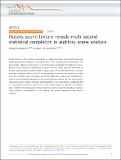Illusory sound texture reveals multi-second statistical completion in auditory scene analysis
Author(s)
McWalter, Richard; McDermott, Josh H
DownloadPublished version (1.818Mb)
Publisher with Creative Commons License
Publisher with Creative Commons License
Creative Commons Attribution
Terms of use
Metadata
Show full item recordAbstract
© 2019, The Author(s). Sound sources in the world are experienced as stable even when intermittently obscured, implying perceptual completion mechanisms that “fill in” missing sensory information. We demonstrate a filling-in phenomenon in which the brain extrapolates the statistics of background sounds (textures) over periods of several seconds when they are interrupted by another sound, producing vivid percepts of illusory texture. The effect differs from previously described completion effects in that 1) the extrapolated sound must be defined statistically given the stochastic nature of texture, and 2) the effect lasts much longer, enabling introspection and facilitating assessment of the underlying representation. Illusory texture biases subsequent texture statistic estimates indistinguishably from actual texture, suggesting that it is represented similarly to actual texture. The illusion appears to represent an inference about whether the background is likely to continue during concurrent sounds, providing a stable statistical representation of the ongoing environment despite unstable sensory evidence.
Date issued
2019Department
Massachusetts Institute of Technology. Department of Brain and Cognitive Sciences; Center for Brains, Minds, and Machines; McGovern Institute for Brain Research at MITJournal
Nature Communications
Publisher
Springer Science and Business Media LLC